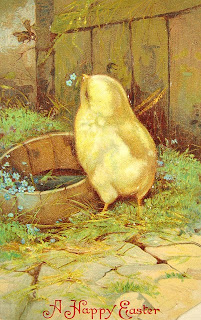Inspired by those fetching Depression era plates my mother had carted home, I purchased this, an emerald green glass teacup in the Fire-King brand Charm pattern produced by Anchor Hocking from 1950 through 1956. This marked the beginning of a fairly brief but passionate interest in acquiring as much Fire-King glassware as I could afford. I now have a lot of it. If ever I needed to preoccupy myself with the sort of purposeful wish-fulfillment that might bring down to a simmer a roiling cauldron of deeply seated uncertainties seasoned with existential dread than this was it. Isn't that why people collect things?
Anyway, I properly fell in love with this. This green color was known as Forest Green and was never officially designated as a part of the Charm line which was typically associated with the colors Jadite and Azurite. Fire-King was inexpensive and utilitarian. It was given away in bags of flour as a promotional item or could be purchased at the grocer's or the gas station.
There were eleven pieces in the Charm pattern. Above is the dessert bowl. I'm not entirely sure why I was so taken with this green. I almost never use it. I know some collectors put this out at Christmas, but I have never been susceptible to the arbitrary social constructs that require me to wear red for Valentine's Day or green for St. Patrick's Day, so I will not be exhuming this for festive holiday use.
Here's an example of the same pattern in Azurite, an icy barely-blue. I do find this rather more appealing than the green.
Charming as Charm was, I was fairly quick to spot the design flaw. It's not always a simple matter to drink from square teacups. I graduated to the conventional form with this Turquoise Blue line produced between 1956 and 1958. It was promoted as dinnerware but marked Oven-Ware which meant you could pre-warm your glass before serving, as you do. There are sixteen pieces in this line.
A Fire-King mug with the "D" handle. I believe the "C" handle is somewhat more collectible.
I really do love this, the cup and saucer from the Restaurant Ware line made from 1948-1967. I have several sets. This is real hairy-chested man stuff, heat-proof and made specifically for mass feeding establishments. It was billed as "highest quality restaurant ware at popular prices" - $2.00 for a box of one dozen cups, $3.30 for one dozen dinner plates.
I know what you're thinking - why does our gentle author have so many cups and saucers?
I suspect that this has something to do with it - this is just a fraction of my grandmother's collection of quaint porcelain teacups. She had an astonishing number of these, all beautifully arranged on a cupboard that spanned the width of a wall. She collected these as well as porcelain shoes and vividly glazed pottery turtles. I suppose my impulse toward collecting is genetic and nostalgic in equal measure.
Here, a lovely piece of Dresden. Compared with the modest Fire King, this is a radiant Leslie Caron in a hat. On the Champs-Elysees. With Louis Jourdan, naturellement.
Then, there was this - Swedish Modern. Yes, Charm was charming but why settle for charming when you can cosy up with irresistible? Oh Swedish Modern, how do I love thee? Let me count the ways. You're beautiful, you come in this gorgeous robin's egg blue, your design is perfect, you elegantly do the job you were designed to do, if life consists of pouring batter into a cake pan, then yes, you make life easier and you're called Swedish Modern, which just breathes "mid-century" and decorates the mind with images of beautifully handknit apres-ski togs, and Arne Jacobsen Egg Chairs, even though he was Danish, and young, fresh uncomplicated people who enjoy life and eat full-fat dairy products.
A mixing bowl in the Swirl pattern. It's back to America and the
Ohio River Valley with this - more prosaic, less design-y and inspirational,
but delightful nonetheless. More Betty Crocker and less Liv Ullmann.
Who was Norwegian.










































